Bridge Abutment Means
Important Point
As a component of a bridge, the abutment provides the vertical support to the bridge superstructure at the bridge ends, connects the bridge with the approach roadway, and retains the roadway base materials from the bridge spans.
Although there are numerous types of abutments and the abutments for the important bridges may be extremely complicated, the analysis principles and design methods are very similar.
In this article, the topics related to the design of conventional highway bridge abutments are discussed and a design example is illustrated.
Unlike the bridge abutment, the earth-retaining structures are mainly designed for sustaining lateral earth pressures.
What Is Bridge Abutment?
A bridge abutment is a substructure that supports one terminus of the superstructure of a bridge and, at the same time, laterally supports the embankment which serves as an approach to the bridge.
For a river bridge, the abutment also protects the embankment from scour of the stream.
Bridge abutments can be made of masonry plain concrete or reinforced concrete.
Also, read : One Way Slab and Two Way Slab Design Step by Step
5 Types of Abutments
The types of Abutments are as follows.
- Closed Abutment.
- Stub or Perched Abutment.
- Pedestal or Spill-through Abutment.
- Integral End Bents.
- Mechanically Stabilized Abutment
1. Closed Abutment
Typical full height closed abutment
A closed abutment is a full-height wall with wing walls on each side that retains the full height of the approach embankment. This type of abutment minimizes the required span length of the bridge. However, there are several significant disadvantages, especially for high embankments and embankments on soft foundations.
The abutment must be constructed before the adjacent embankment. Proper placement and compaction of backfill are difficult in the restricted area between the and the wing walls. If heavy equipment is used to compact the backfill, the wall may be pushed laterally and out of vertical alignment.
The weight of the backfill will contribute to the compression of soft foundation soils and the post-construction settlement of the embankment and abutment. If the abutment is supported on piles, the compression of the foundation soil will produce down drag, which may overstress the piles.
Closed abutments must be designed for the lateral earth pressures exerted by the full height of the approach embankment. Rankine earth pressure theory or equivalent fluid pressures conventionally are used.
Because the lateral force and the overturning moment about the base of the wall are proportional to the square and the cube of the wall height, respectively, the structural requirements and cost of the wall increase rapidly with height.
Also, read: IS 1200 Important Point Part-2
2. Stub or Perched Abutment
A stub or perched abutment is a relatively short abutment that is constructed after the embankment has been completed. The embankment can be compacted without interference from the abutment, and, if necessary, the abutment construction can be delayed until the compression of the foundation soils caused by embankment loads is completed.
Thus, post-construction settlements may be minimized. The abutment may be supported on spread footings in the embankment or on piles or drilled shafts constructed through the fill, as shown in the above figure.
Because the stub abutment is relatively short and located in the upper part of the fill, the lateral earth pressure is relatively small in comparison to the pressure against a full-height closed abutment.
However, longer bridge spans may be required than for a full-height abutment. Stub abutments also are used on the natural ground in cut slopes. Spread footing, pile, or drilled shaft foundations may be used.
Also, read: What Is Bridge Pier | Type of Bridge Pier
3. Pedestal or Spill-through Abutment
Typical Spill-through Abutment
Pedestal or spill-through abutments are short stub-type abutments supported on pedestals or columns extending to the natural ground. As with closed abutments, the abutment must be constructed before the approach embankment.
Then the fill is placed simultaneously on both sides of the pedestals to minimize the unbalanced earth pressure and the lateral movement of the abutment. However, the fill around the pedestals is very difficult to compact properly. It also is very susceptible to erosion unless the end slope is protected with paving, riprap, etc.
The lateral earth pressures against a spill-through are less than for a full-height closed abutment but greater than for a stub abutment. The weight of the fill that is placed after the construction of the abutment may cause compression of soft foundation soils and the same detrimental post-construction effects that have been described for closed abutments.
Also, read: Difference Between Bridge and Culvert | What Is Bridge | What Is Culvert
4. Integral End Bents
Typical Integral Abutment.
Integral end bents are stub abutments that are rigidly connected to the superstructure without expansion joints. The connection is designed for full transfer of thermal stresses from the bridge deck to the abutment.
The elimination of expansion joints with movable bearing systems for the deck is reported to reduce construction and maintenance costs. Various designs are used by different state agencies, but almost all require steel H-piles for support of integral abutments. A typical integral end bent is shown in the above figure.
Integral abutments have been used in the United States for about 30 years. Early applications in Kansas, Missouri, Ohio, and Tennessee were restricted to relatively short bridges, generally less than 100 ft (30 m) long.
Today integral abutments are used in more than half of the states, and the allowable lengths have increased significantly. Greimann et al cite the successful use of integral abutments for continuous-steel and concrete bridges with lengths of 300 ft (90 m) and 500 to 600 ft (150 to 180 m), respectively.
Almost all states that use integral abutments on piles indicate that they are performing well. Despite the apparent increasing popularity of integral abutments, some problems have been noted. These problems generally are related to cyclic lateral movements of the abutment in response to thermal stresses in the bridge deck.
Cracking and buckling of approach pavements have been reported. The approach pavement design must include careful consideration of the thermal effects from integral abutments.
Because most backfill materials are not perfectly elastic, cyclic abutment movements create voids between the backfill and the abutment, which permit erosion of the backfill and progressive deterioration and settlement of the backfill.
Groundwater or surface water that enters the backfill through pavement cracks accelerates the erosion process.
Special Integral Abutment Design
Some states use special details to accommodate the cyclic abutment movements. For example, one North Dakota design, which is illustrated in the above figure, provided a pressure relief system between the backfill and the but merit.
Narrow vertical strips of 4 in (100 mm) thick compressible material were attached at 4 ft (1.2 m) intervals along with the hack of the abutment. Corrugated metal sheets were placed behind the compressible strips to maintain a 4 in (100 mm) void between the abutment and the backfill.
Also, to facilitate lateral movement of the H-piles, 2 in (50 mm) thick compressible material was glued to both sides of the upper 20 ft (6 m) of the web. An oversize hole was drilled to a depth of 20 ft (6 m), and the pile was placed in this hole and driven to a depth of approximately 110 ft (33 m).
The oversize hole was backfilled with sand. The performance of this system is reported by Jorgenson. The performance of integral abutments could be improved by the development of new compressible elastic materials that could be installed easily between the abutment and the backfill.
The ideal material would have elastic properties that permit large recoverable cyclic movements and hydraulic properties that provide adequate drainage without erosion of lines from the backfill.
Also, almost all agencies require steel H-piles for support of integral abutments, on the assumption that this facilitates lateral movement.
Currently, there is no evidence to support this hypothesis. Significant savings could be realized if it were demonstrated that integral abutments on spread footings will perform as well as those supported on piles.
Also, read: Difference Between Flyover and Bridge | What Is Flyover | What Is Bridge
5. Mechanically Stabilized Abutment
Schematic Diagram of Mechanically Stabilized Abutment
Mechanically stabilized walls, also have been used to support bridge abutments. The bridge seat and footing are supported directly on the reinforced backfill, as shown schematically in the above figure.
The design concepts for the mechanically stabilized walls are applicable. The abutment loads increase the reinforcement requirements, especially in the upper part of the backfill, where the bridge loads are concentrated.
However, the facing elements are not affected because the facing does not support structural loads. There are many proprietary systems that are based on different design assumptions, but generic design procedures are recommended by Mitchell and Vinci and Christopher et al.
Because mechanically stabilized abutments can tolerate large deformations, they often are an economical alternative to deep foundations or treatment of soft foundation soils.
For example. in 1972 mechanically stabilized abutments were used for a bridge across the Moselle River at Thionville, France because large approach fills settlements were anticipated.
The abutment was surcharged until 12 in (0.3 m) of settlement occurred and then the superstructure was constructed. Six months after completion of the superstructure, the bridge seat was jacked 2.4 in (60 mm) to compensate for additional settlement.
Since the bridge was opened to traffic, less than 0.5 in. (12 mm) of settlement has been observed. Because the abutment and approach fill settle as one unit, a differential settlement between the bridge deck and the approach roadway is virtually eliminated.
The speed and case of construction have contributed to the wide-spread use of mechanically stabilized abutments in the United States.
They are especially useful for new and rehabilitation projects in urban areas where right-of-way and work areas often are restricted. For example, they have been used extensively in the Atlanta area. Also, tied-back abutments have been used for widening and rehabilitation projects in cuts.
Concrete Abutment
Abutments support the ends of the bridge and transfer the loads from the superstructure into the ground. The abutments also support the bearing devices and the backwalls. Abutments are usually constructed of concrete. There are various types of abutments including wall, stub, integral, and semi-integral.
Wing Wall in Bridge
In a bridge, the wing walls are adjacent to the abutments and act as retaining walls. They are generally constructed of the same material as those of abutments. The wing walls can either be attached to the abutment or be independent of it.
Bridge Abutment Types
The four main types of abutments include the typical gravity abutment, the most common type of abutment that includes all of the components to hold the bridge’s deck while including a retaining wall for the embankment; U-abutment, which is a form of abutment that differs from a gravity abutment in the angle of the wing.
How Are Bridge Supports Built in Water?
When bridges requiring piers are built over a body of water, foundations are made by sinking caissons into the riverbed and filling them with concrete. Next, the anchorages are built on both ends, usually of reinforced concrete with embedded steel eyebars to which the cables will be fastened.
Precast Concrete Bridge Abutment
A precast concrete bridge abutment refers to a structural component used in the construction of bridges. An abutment is typically located at each end of a bridge span and provides support and stability to the bridge deck. Precast concrete abutments are manufactured off-site in a controlled environment and then transported to the bridge construction site for installation.
Here are some key points about precast concrete bridge abutments:
- Precast Concrete
- Abutment Function
- Precast Abutment Construction
- Transportation and Installation
- Design Flexibility
- Maintenance and Durability
Bridge Abutment Design Guidelines
Design guidelines for bridge abutments can vary depending on specific project requirements, local building codes, and engineering standards. However, here are some general considerations and guidelines that are typically followed in the design of bridge abutments:
- Load Requirements
- Soil Investigation
- Foundation Design
- Retaining Wall Design
- Structural Design
- Water Drainage
- Construction Considerations
- Durability and Maintenance
- Compliance and Documentation
Bridge Abutment Construction Cost
The construction cost of a bridge abutment can vary significantly depending on various factors such as the bridge design, location, size, materials used, site conditions, labor costs, and market conditions. It is challenging to provide an exact cost without specific project details, but I can offer some general insights.
- Size and Complexity
- Material Costs
- Site Preparation
- Labor Costs
- Market Conditions
- Additional Factors
Bridge Abutment Types and Materials
Bridge abutments can be constructed using various types of materials, depending on factors such as design requirements, site conditions, and project specifications. Here are some common types of bridge abutments and the materials typically used for their construction:
- Concrete Abutments
- Masonry Abutments
- Steel Abutments
- Timber Abutments
- Composite Abutments
Bridge Abutment Inspection Checklist
A bridge abutment inspection checklist is a useful tool for engineers and inspectors to ensure that bridge abutments are thoroughly examined for any structural or maintenance issues. While the specific checklist items may vary depending on project requirements and local regulations, here are some general items that are commonly included in a bridge abutment inspection checklist:
- Visual Inspection:
- Foundation and Substructure
- Reinforcement and Concrete
- Drainage
- Accessibility and Safety
- Documentation
Abutment Bridge
An abutment is a structural element used in bridge construction. It supports and distributes the loads from the bridge superstructure (the portion above the abutment) to the ground or supporting piers. Abutments are typically located at each end of the bridge span and are responsible for transferring the bridge’s weight and loads to the ground.
Abutment Meaning
A structure built to support the lateral pressure of an arch or span, e.g. At the ends of a bridge.
Abutment Definition
An abutment is a structure that supports and anchors the ends of an arch, dam, bridge, or other similar structures. It is specifically designed to transmit the loads from the superstructure to the ground or supporting elements.
Abutment Wall
An abutment wall is a structure that is typically built at the ends of a bridge or any other type of elevated structure to provide support and stability. It is designed to resist the lateral forces and transmit the loads from the bridge or structure to the ground or foundation.
Abutments Bridge
Abutments are integral components of bridge structures. They are the supports or foundations at each end of a bridge that provide stability and transfer the loads from the bridge deck to the ground or foundation. Abutments are typically made of reinforced concrete or masonry and are designed to resist the forces and moments imposed by the bridge.
What Is a Bridge Abutment?
A bridge abutment is a structure that supports the ends of a bridge or viaduct. It serves as a foundation for the bridge, providing stability and transferring the loads from the bridge superstructure to the ground. Abutments are typically located at the points where the bridge meets the solid ground or other support structures.
What Are Abutments?
Abutments are structures that provide support and stability to various types of constructions, including bridges, retaining walls, and buildings. They are typically located at the ends of these structures and serve as a connection between the superstructure and the ground or foundation.
A Bridge with a Single Span Has How Many Number of Abutments That Offer Vertical and Lateral Support?
A bridge with a single span typically has two abutments—one at each end of the span. These abutments provide both vertical and lateral support for the bridge. The abutments bear the vertical loads from the bridge, including the weight of the superstructure and any live loads. They also resist lateral forces such as wind loads and soil pressure, ensuring the stability of the bridge. The two abutments work together to support the entire structure and transfer the loads to the ground or foundation.
Like this post? Share it with your friends!
Suggested Read –
- Road Development Plans in India
- What Does Parapet Mean | Types of Parapet Wall | Uses of Parapet Wall
- What Is Dry Pack Mortar | Advantages of Dry Pack Mortar | Disadvantages of Dry Pack Mortar
- What Is Caisson Foundation | Types of Caisson Foundation | Advantage, Disadvantage, Application, & Construction of Caisson
- What Is Hempcrete | Hempcrete Blocks | Advantages & Disadvantages of Hempcrete Blocks | Applications of Hempcrete
- What Is Hard Hat | Hard Hat Colour Definition | Different Hard Hat Colour Codes | Types of Safety Helmets | Classification of Hard Hats
Originally posted 2023-05-23 15:40:20.
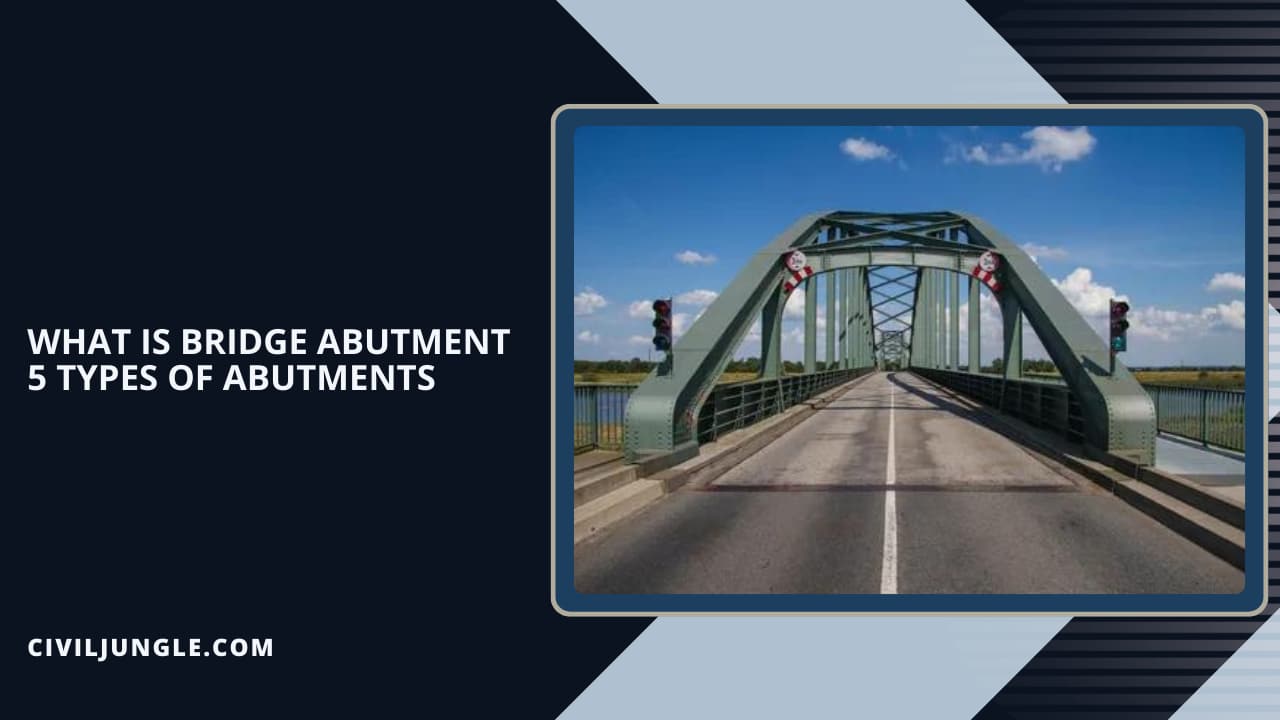
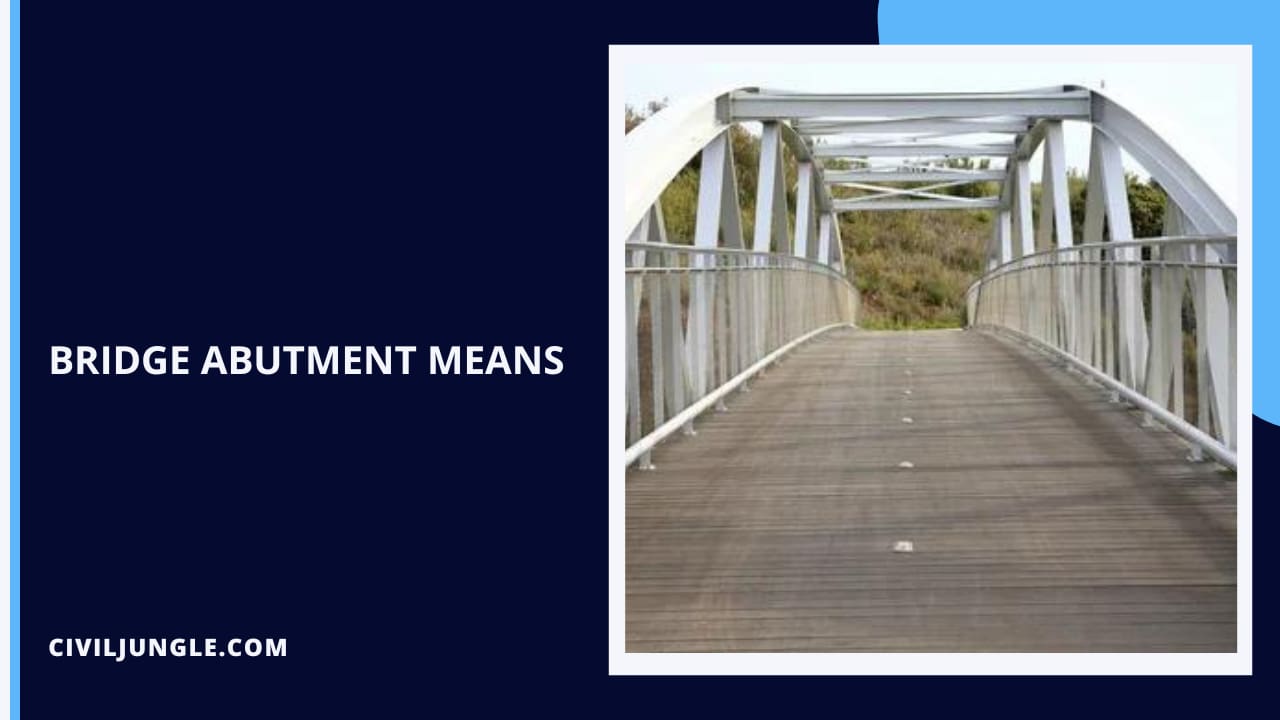
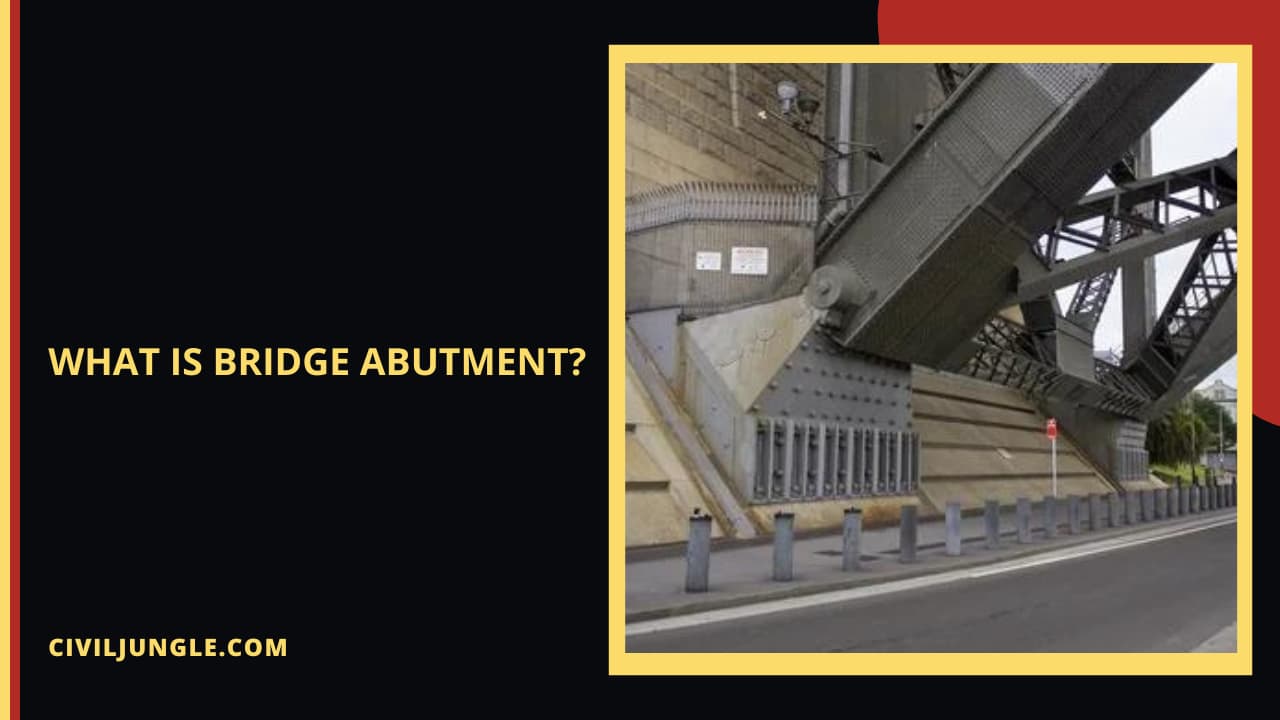
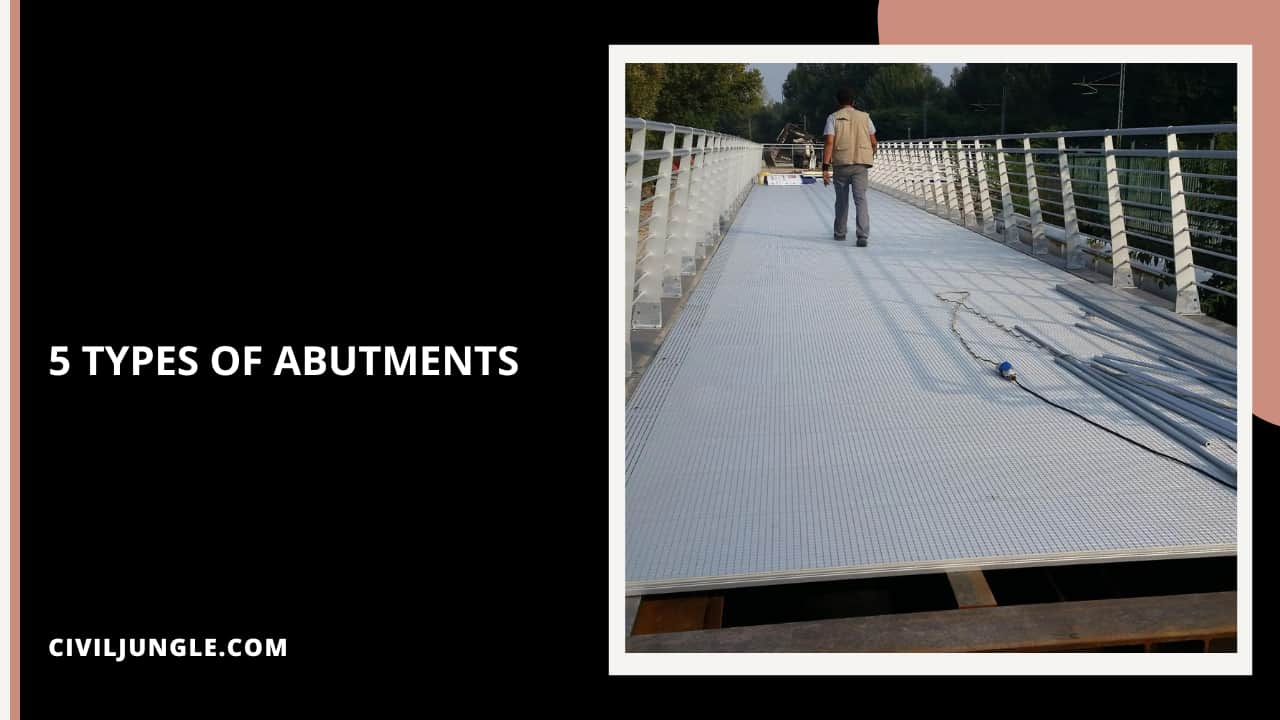
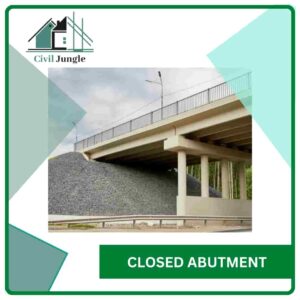

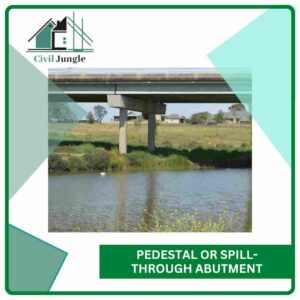
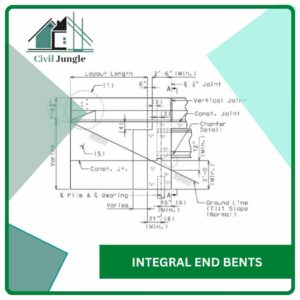
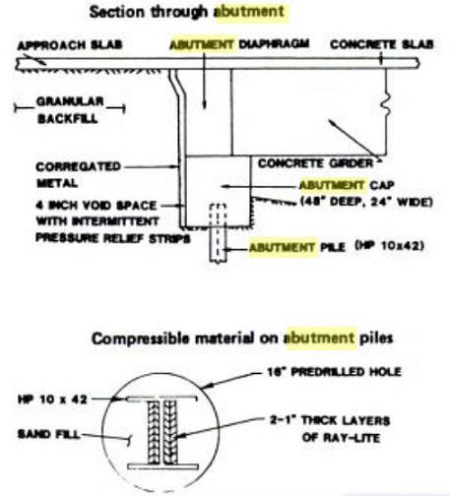
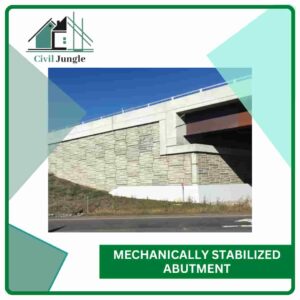

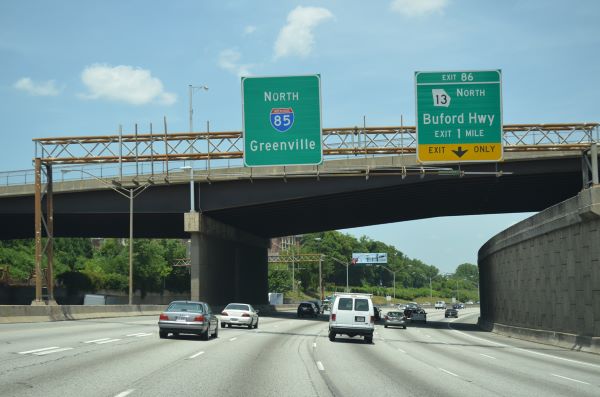

Leave a Reply